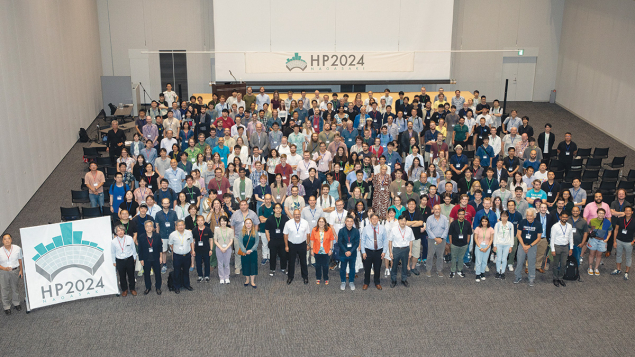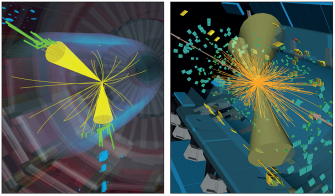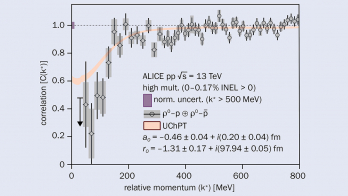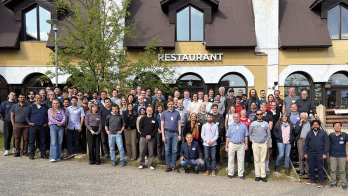
The 12th edition of the International Conference on Hard and Electromagnetic Probes attracted 346 physicists to Nagasaki, Japan, from 22 to 27 September 2024. Delegates discussed the recent experimental and theoretical findings on perturbative probes of the quark–gluon plasma (QGP) – a hot and deconfined state of matter formed in ultrarelativistic heavy-ion collisions.
The four main LHC experiments played a prominent role at the conference, presenting a large set of newly published results from studies performed on data collected during LHC Run 2, as well as several new preliminary results performed on the new data samples from Run 3.
Jet modifications
A number of significant results on the modification of jets in heavy-ion collisions were presented. Splitting functions characterising the evolution of parton showers are expected to be modified in the presence of the QGP, providing experimental access to the medium properties. A more differential look at these modifications was presented through a correlated measurement of the shared momentum fraction and opening angle of the first splitting satisfying the “soft drop” condition in jets. Additionally, energy–energy correlators have recently emerged as promising observables where the properties of jet modification in the medium might be imprinted at different scales on the observable.
The first measurements of the two-particle energy–energy correlators in p–Pb and Pb–Pb collisions were presented, showing modifications in both the small- and large-angle correlations for both systems compared to pp collisions. A long-sought after effect of energy exchanges between the jet and the medium is a correlated response of the medium in the jet direction. For the first time, measurements of hadron–boson correlations in events containing photons or Z bosons showed a clear depletion of the bulk medium in the direction of the Z boson, providing direct evidence of a medium response correlated to the propagating back-to-back jet. In pp collisions, the first direct measurement of the dead cone of beauty quarks, using novel machine-learning methods to reconstruct the beauty hadron from partial decay information, was also shown.
Several new results from studies of particle production in ultraperipheral heavy-ion collisions were discussed. These studies allow us to investigate the possible onset of gluon saturation at low Bjorken-x values. In this context, new results of charm photoproduction, with measurements of incoherent and coherent J/ψ mesons, as well as of D0 mesons, were released. Photonuclear production cross-sections of di-jets, covering a large interval of photon energies to scan over different regions of Bjorken-x, were also presented. These measurements pave the way for setting constraints on the gluon component of nuclear parton distribution functions at low Bjorken-x values, over a wide Q2 range, in the absence of significant final-state effects.
New experiments will explore higher-density regions of the QCD–matter phase diagram
During the last few years, a significant enhancement of charm and beauty-baryon production in proton–proton collisions was observed, compared to measurements in e+e– and ep collisions. These observations have challenged the assumption of the universality of heavy-quark fragmentation across different collision systems. Several intriguing measurements on this topic were released at the conference. In addition to an extended set of charm meson-to-meson and baryon-to-meson production yield ratios, the first measurements of the production of Σc0,++(2520) relative to Σc0,++(2455) at the LHC, obtained exploiting the new Run 3 data samples, were discussed. New insights on the structure of the exotic χc1(3872) state and its hadronisation mechanism were garnered by measuring the ratio of its production yield to that of ψ(2S) mesons in hadronic collisions.
Additionally, strange-to-non-strange production-yield ratios for charm and beauty mesons as a function of the collision multiplicity were released, pointing toward an enhanced strangeness production in a higher colour-density environment. Several theoretical approaches implementing modified hadronisation mechanisms with respect to in-vacuum fragmentation have proven to be able to reproduce at least part of the measurements, but a comprehensive description of the heavy-quark hadronisation, in particular for the baryonic sector, is still to be reached.
A glimpse into the future of the experimental opportunities in this field was also provided. A new and intriguing set of physics observables for a complete characterisation of the QGP with hard probes will become accessible with the planned upgrades of the ALICE, ATLAS, CMS and LHCb detectors, both during the next long LHC shutdown and in the more distant future. New experiments at CERN, such as NA60+, or in other facilities like the Electron–Ion Collider in the US and J-PARC-HI in Japan, will explore higher-density regions of the QCD–matter phase diagram.
The next edition of this conference series is scheduled to be held in Nashville, US, from 1 to 5 June 2026.








